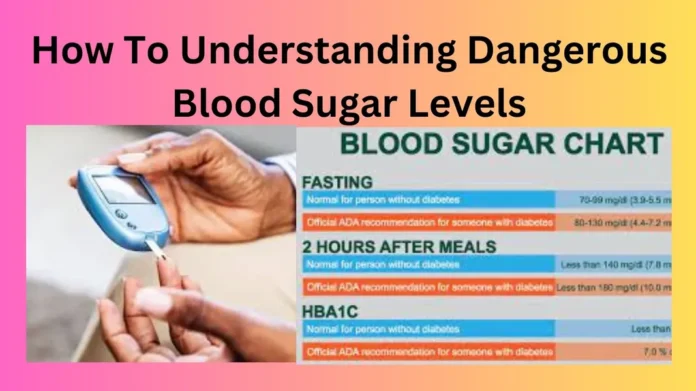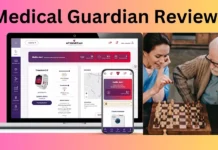Individuals managing diabetes are constantly fighting with the necessity to keep the blood sugar level within a particular range. The balance is a mix of proper diet, regular exercise and a strict compliance with the diabetes treatment regimens prescribed to them.
Controlling blood sugar levels effectively prevents serious health issues related to diabetes, including renal and cardiac conditions and visual impairment. However, too either low or high blood sugar levels may create serious health risks in the absence of proper control.
This article is designed to explain the concept of hazardous high blood sugar levels and how they are calculated and the implications for diabetics.
Understanding Blood Sugar Levels
The medical condition of diabetes is that is characterized by high level of blood sugar. Healthcare professionals employ various criteria to establish a diagnosis for diabetes.
A1C tests are a must. A1C test is crucial in assessing the average blood sugar levels for the previous 2 to 3 months. A reading of less than 5.7 percent falls in the norm, whereas an A1C reading that is higher than this but being below 6.4 percent indicates prediabetes. A A1C measurement of 6.5 or higher is a sign of a diagnosis of diabetes.
The test for fasting blood sugar determines the level of your glucose after the night’s fast. Normal results are usually lower than 100 mg/dL with results that range between 100 and 125 mg/dL which indicate prediabetes. A fasting blood glucose reading that is 126 mg/dL or higher is an indication of diabetes.
The blood sugar test can be performed without a fasting requirement A result of 200 mg/dL and higher is a proof of a diagnosis of diabetes.
In the end, the glucose tolerance test tests the body’s response to glucose. It also evaluates the blood sugar levels prior to and after you consume glucose. Two hours after consumption A blood sugar reading of 140 mg/dL or less is considered to be healthy. The readings that fall between 199 and 140 mg/dL are indicative of prediabetes. A 200 mg/dL or more indicates diabetes.
Identifying dangerously high blood sugar levels
- Hyperglycemia, or high blood glucose, is marked by readings between 180 mg/dL and 250 mg/dL.
- A score that is higher than 250 mg/dL is a serious risk and requires immediate medical attention.
- Readings that follow of 300 mg/dL or more can be extremely dangerous and cause severe complications such as diabetes ketoacidosis as well as diabetes Coma.
- Blood sugar levels that exceed 600 mg/dL could be life-threatening and lead to a condition called hyperglycaemic non-ketotic syndrome (HHNS).
Identifying dangerously low blood sugar levels
Blood sugar levels of less than 70 mg/dL are categorized as hypoglycemia, as well as insufficient blood sugar. A reading of less than 50 mg/dL indicates extreme hypoglycemia, and could be dangerous. A blood sugar reading is an emergency medical situation that requires immediate medical intervention.
Noticing alarmingly high or low blood Sugar levels
Blood sugar levels that persist lower than 50 mg/dL and above 250 mg/dL is cause for worry and should be accompanied by medical attention, regardless of DIY solutions.
High Blood Sugar levels with Typ 2 Diabetes
For those who suffer from diabetic type 2, the goal is to maintain the levels of glucose between 70 mg/dL to 130 mg/dL prior to meals, and keep them at 180 mg/dL, or lower after meals.
Frequent fluctuations outside this range pose a High risk of developing diabetes complications” high risk of developing complications due to diabetes. These circumstances call for greater efforts towards healthier eating regularly exercising, as well as losing weight. Also, talks with your physician regarding the need to adjust your diabetes medication might be required.
Recognizing High Blood Sugar Symptoms
Hyperglycemia, which is also known as high blood sugar, may be caused by dietary mistakes or illness, as well as ineffective doses of insulin or the administration.
Warning signals comprise:
- More thirst
- Frequent urination
- Blurred vision
- Dry mouth and dry skin
- Headaches
- Fatigue
- Severe muscle discomfort
The symptoms of diabetic ketoacidosis can include nausea and abdominal pain, vomiting sweet-smelling breath, and a shortness of breath.
When blood sugar levels surge to 600 mg/dL or more diabetic hyperosmolar syndrome) symptoms can include a high thirst and confusion, drowsiness, seizures, and dark urine. In addition, other therapies such as rapid-acting insulin are able to control these hyperglycemic blood levels that are dangerously high.
Identifying the Signs of Low Blood Sugar
Hypoglycemia, also known as low blood sugar levels can result from a lack of food as well as over-using insulin and other diabetes medication, or taking part in a lot of physical activity.
The signs for low blood sugar are:
- Shaking
- Sweating
- Hunger
- Weakness
- Headaches
- Drowsiness anddrowsiness
- Vision extremely blurred
- Breathlessness
- Irritability as well asconfusion
- Heart palpitations
- Slurred speech
The treatment of lower blood sugar levels at home can include drinking a drink or food and taking glucose pills and then an examination of the blood sugar after 15 minutes to be sure that it is within the desired range.
In case of severe hypoglycemia leading to loss of consciousness, emergency medical intervention is necessary, possibly requiring an injection of glucagon, a hormone that rapidly elevates blood sugar levels.
Wrapping Up
The lack of awareness of hypoglycemia and hyperglycemia can greatly increase the risk of developing diabetes. Recognizing what causes hazardous blood sugar levels, and also recognizing the symptoms and signs that indicate it is vital.
If you are having trouble managing diabetes as your levels of blood sugar regularly diverge from your healthy range, talk to your doctor about the continuous glucose monitor (CGM). This monitors the levels of your blood sugar during the entire day allowing you to detect trends and fluctuations.
If you are frequently experiencing low blood sugar levels, you should review the treatment plan you are taking with your physician because you could have more than prescribed amount of insulin. However the presence of elevated blood sugar levels for prolonged periods could require an appointment with your doctor regarding adjusting the dosage of insulin or any other medication. A pump for insulin could be beneficial in managing your health condition and managing high blood sugar more effectively.
Maintaining Well-being and Health with Diabetes
In tackling the disease and keeping blood sugar levels from becoming dangerous changes in lifestyle are crucial. Maintaining a balanced and healthy diet is crucial to regulating the blood sugar level. High in nutrient-rich foods, rich in lean proteins, fiber and healthy fats like avocado, salmon nuts, avocado, and whole grain, must be part of your daily routine.
It is equally important to manage the effects of stress. Chronic stress can affect your body’s insulin resistance and cause fluctuations in the levels of blood sugar. Meditation, deep breathing, or mindfulness can aid in managing stress effectively.
Physical activity is vital to keeping good glucose levels. Regular exercise or yoga will help increase the sensitivity of insulin, decrease stress, and help with weight control that is crucial in managing the effects of diabetes. Always consult your doctor prior to beginning a new exercise routine.
Conclusion
The management of weight is a different aspect. A high weight particularly in the midsection area, may increase your body’s resistance to insulin, resulting in more glucose levels. Being healthy and fit can dramatically reduce your chance of developing complications related to diabetes.















